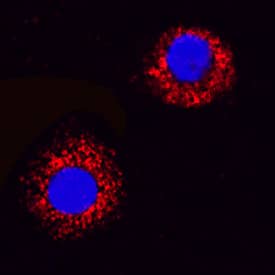Canine VEGF164 Antibody
R&D Systems, part of Bio-Techne | Catalog # AF1603


Key Product Details
Species Reactivity
Validated:
Canine
Cited:
Bovine, Canine
Applications
Validated:
Immunocytochemistry, Neutralization, Western Blot
Cited:
Immunohistochemistry-Frozen, Western Blot
Label
Unconjugated
Antibody Source
Polyclonal Goat IgG
Product Specifications
Immunogen
E. coli-derived recombinant canine VEGF164
Pro28-Arg190
Accession # Q9MYV3
Pro28-Arg190
Accession # Q9MYV3
Specificity
Detects canine VEGF164 in direct ELISAs and Western blots. In direct ELISAs and Western blots, approximately 50% cross-reactivity with recombinant human VEGF, recombinant mouse VEGF, and recombinant rat VEGF is observed.
Clonality
Polyclonal
Host
Goat
Isotype
IgG
Endotoxin Level
<0.10 EU per 1 μg of the antibody by the LAL method.
Scientific Data Images for Canine VEGF164 Antibody
Cell Proliferation Induced by VEGF and Neutralization by Canine VEGF Antibody.
Recombinant Canine VEGF (Catalog # 1603-CV) stimulates proliferation in HUVEC human umbilical vein endothelial cells in a dose-dependent manner (orange line). Proliferation elicited by Recombinant Canine VEGF (15 ng/mL) is neutralized (green line) by increasing concentrations of Goat Anti-Canine VEGF164Antigen Affinity-purified Polyclonal Antibody (Catalog # AF1603). The ND50 is typically 0.04-0.10 µg/mL.VEGF in Canine PBMCs.
VEGF was detected in immersion fixed canine peripheral blood mononuclear cells (PBMCs) using Goat Anti-Canine VEGF 164 Antigen Affinity-purified Polyclonal Antibody (Catalog # AF1603) at 15 µg/mL for 3 hours at room temperature. Cells were stained using the NorthernLights™ 557-conjugated Anti-Goat IgG Secondary Antibody (red; Catalog # NL001) and counterstained with DAPI (blue). Specific staining was localized to cell secretion. View our protocol for Fluorescent ICC Staining of Non-adherent Cells.Applications for Canine VEGF164 Antibody
Application
Recommended Usage
Immunocytochemistry
5-15 µg/mL
Sample: Immersion fixed canine peripheral blood mononuclear cells
Sample: Immersion fixed canine peripheral blood mononuclear cells
Western Blot
0.1 µg/mL
Sample: Recombinant Canine VEGF (Catalog # 1603-CV)
Sample: Recombinant Canine VEGF (Catalog # 1603-CV)
Neutralization
Measured by its ability to neutralize VEGF-induced proliferation in HUVEC human umbilical vein endothelial cells. The Neutralization Dose (ND50) is typically 0.04-0.10 µg/mL in the presence of 15 ng/mL Recombinant Canine VEGF.
Formulation, Preparation, and Storage
Purification
Antigen Affinity-purified
Reconstitution
Reconstitute at 0.2 mg/mL in sterile PBS. For liquid material, refer to CoA for concentration.
Formulation
Lyophilized from a 0.2 μm filtered solution in PBS with Trehalose. *Small pack size (SP) is supplied either lyophilized or as a 0.2 µm filtered solution in PBS.
Shipping
Lyophilized product is shipped at ambient temperature. Liquid small pack size (-SP) is shipped with polar packs. Upon receipt, store immediately at the temperature recommended below.
Stability & Storage
Use a manual defrost freezer and avoid repeated freeze-thaw cycles.
- 12 months from date of receipt, -20 to -70 °C as supplied.
- 1 month, 2 to 8 °C under sterile conditions after reconstitution.
- 6 months, -20 to -70 °C under sterile conditions after reconstitution.
Background: VEGF
Long Name
Vascular Endothelial Growth Factor
Alternate Names
MVCD1, VAS, Vasculotropin, VEGF-A, VEGFA, VPF
Entrez Gene IDs
Gene Symbol
VEGFA
UniProt
Additional VEGF Products
Product Documents for Canine VEGF164 Antibody
Product Specific Notices for Canine VEGF164 Antibody
For research use only
